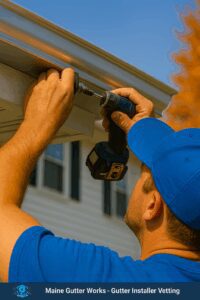The Hidden Price of Stormwater in Vacationland
Nor’easters can unload two months’ worth of rain in a single weekend, while winter storms bury eaves in heavy, wet snow. In 2024, Bangor clocked 41.79 inches of precipitation—almost dead-center on its 30-year average. Yet every inch still has to move safely from roof to soil. No wonder Google searches for “rain gutter installers near me” have doubled in Maine since 2020!
Today, we’ll stack traditional sectional gutters against on-site-rolled seamless systems, teasing out the real long-term savings, maintenance headaches, and even environmental dividends.
Up-Front Investment & Budget Factors
Rather than fixating on a single dollar number, smart homeowners look at the variables that swing a quote up or down:
|
Cost Driver |
Why It Matters |
| Linear footage |
Ranches need ~100 ft; Capes and Colonials can top 240 ft. More footage means more metal, downspouts, and labor. |
| Material & gauge |
Aluminum dominates for its balance of weight, longevity, and price. Copper adds curb appeal but nearly doubles material cost. |
| Installer tooling | Crews who bring a portable roll-former charge a premium but eliminate 80% of potential leak joints, lowering lifetime repairs. |
|
Add-ons |
Leaf guards, snow-melt heat cables, and rain-harvest diverters up the invoice but can pay back in reduced cleanings, ice-dam prevention, and garden irrigation savings. |
| Roof complexity |
Steep pitches, multiple dormers, or three-story elevations require extra crew safety gear and time. |
Rule of thumb: seamless aluminum typically runs a moderate premium over sectional, but most of that delta is labor-tooling rather than raw metal. When you spread that premium over a 25- to 30-year service life, the annual cost difference often narrows to the price of a single pizza night. For granular numbers by region, Angi keeps an updated gutter installation cost range you can plug your zip code into Angi.
Need a tailored quote? Our services page explains how we measure, cut, and price seamless runs without hidden add-on fees. Then give us a call to get your free in-person estimate.
Maintenance Burden: Time, Money & Ladder Safety
Traditional sectional K-style gutters collect needles and maple “helicopters” at every seam. Industry guides recommend cleaning three to four times per year under heavy tree cover. At a national average of $1.00 per linear foot, a two-story Maine home can spend the equivalent of a winter heating bill just on roof-line housekeeping.
Seamless troughs have no mid-span joints, so debris has fewer snag points. Most owners schedule one good autumn flush, adding a quick spring check only if there’s a massive red-pine canopy overhead.
Ladder Risk in Real Numbers
Portable ladders send half-a-million Americans to the ER every year. Electrocutions alone account for 4 % of work-related deaths when ladders hit power lines—an often-overlooked hazard during gutter cleaning. Fewer climbs equal fewer chances to slip, shock, or wrench a shoulder.
Tip: If you still clean twice a year, invest in stabilizer bars and non-conductive fiberglass rails, or let a certified crew handle the dirty work. Our fall maintenance bundles include disposal of bagged debris so it never sits on your lawn.
Maine Climate Stress Test
Freeze–thaw action is public enemy #1 for sectional gutters. As ice expands inside the lap joints, caulk fractures and screws back out, leaving pinholes that funnel meltwater behind fascia boards.
- Ice-dam removal now averages $650–$2,000, depending on the roof size and the method used (steam vs. chisel).
- Undetected leakage can wick into framing and insulation, creating hidden mold colonies.
Seamless gutters limit joints to end caps and corners, so thermal shift is absorbed along a continuous channel—less chance of “saw-tooth” splits. When storms dump snow followed by rain, meltwater reaches the downspout before a re-freeze can trap it on the shingles.
For a deeper dive into storm performance, see our guide on seamless gutters and Maine weather extremes.
Second-Degree Costs of Sectional Failure
- Trim & siding rot – Moist wood invites carpenter ants and requires complete board replacement, not spot patches.
- Foundation micro-cracks – Average Maine repair ranges $2,200–$8,100 depending on stabilization method.
- Landscape erosion & hardscape heave – Overflow carves mulch beds, undermines paver walkways, and can topple stone walls.
- Energy penalties – Wet basement air drives dehumidifier and furnace runtimes, nudging utility bills 8–15 % higher in shoulder seasons.
A continuous gutter channel diverts runoff well away from the drip line, protecting everything from topsoil to sill plate.
Third-Degree Ripple Effects You Might Not Expect
| Hidden Impact | How Seamless Gutters Help | Source |
| Indoor-air quality | Dry basements starve mold spores of moisture, improving respiratory health | US EPA |
| Insurance compliance | Documented gutter maintenance wards off “neglect” claim denials | Better Business Bureau |
| Sustainability | Aluminum is infinitely recyclable; a 30-year life cycle cuts landfill waste in half compared with vinyl | Roof Doctors |
| Community goodwill | Programs like “Gutters for Good” donate surplus metal and free installs to veterans | Times Union |
| Curb appeal & resale | Appraisers flag seamless gutters as a durability upgrade, boosting buyer confidence | Angi ‘Pros Near Me’ Angi |
Maintenance you may need from a gutter installer near me, depending on your home and system type.
|
Season |
Sectional Must-Dos | Seamless Must-Dos | Why It Matters |
|
Spring |
Full debris scoop; seam-gap caulk check | Quick hose flush & slope check | Prevent seed pods from damming summer storms |
|
Summer |
Mid-season spot clean under maples | Visual downspout check after a thunderstorm |
Heavy July downpours can overflow half-clogged troughs |
|
Fall |
Leaf clean, spike re-seat, hanger tighten | Single leaf flush (add guard install if needed) |
70 % of annual debris falls in 10 weeks |
| Winter Prep | Install heat cables; inspect lap joints for cracks | Confirm downspouts clear, heat cables optional |
Freeze-thaw splits occur first at sectional seams |
Choosing the Right Gutters Installers Near Me—Beyond “Lowest Bidder”
- Licensing & Insurance – Verify that your “rain gutter installers near me” hold a Maine Home Construction Contracting license and carry at least $1 M liability coverage. Unlicensed work can void insurance claims if water damage occurs later.
- On-Site Roll-Forming – Ask whether the crew fabricates gutters in one continuous run; portable roll-formers eliminate 80 % of future leak points.IRoof
- Hidden Hangers & Screw Fasteners – Spikes loosen in freeze cycles; screws every 24″ support the 20 lb-per-foot snow loads common along the coast.
- Warranty Split – Look for 20-year finish / 5-year labor at minimum. Anything less suggests thin metal or untrained installers.
- Local References – Demand addresses within 30 miles. A quick drive-by tells you how well those corners are holding up after a Nor’easter.
- Cleanup & Payment Schedule – A reputable contractor leaves no scrap metal behind and never front-loads more than 30 % of the project cost.
Explore how we hit each checkpoint in our post on why homeowners trust seamless gutters year-round.
Conclusion—The Right Gutter Installation for Smart Drainage, Safer Homes, & Bigger Savings
Sectional gutters look cheaper until you tally the ladder hours, joint reseals, and emergency ice-dam calls. Seamless systems fabricated by reputable rain gutter installers near me cost a little more on install day—but they repay you in lower maintenance bills, fewer safety risks, and a healthier, drier home.
Ready to crunch your own numbers? Get a free, no-pressure quote from the team Mainers trust for precision roll-forming and storm-ready installs—Maine Gutter Works.

Recent Comments